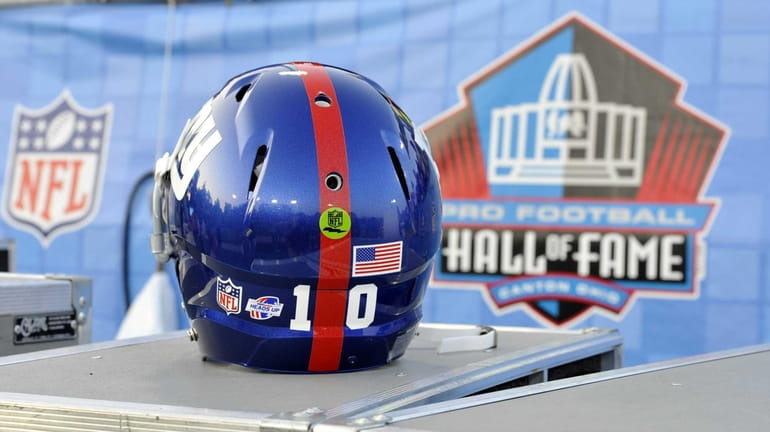Helmet communication depends on many factors

The helmet of Giants quarterback Eli Manning with the green radio communication sticker sits behind the bench prior to the Pro Football Hall of Fame exhibition NFL football game against the Buffalo Bills Sunday, Aug. 3, 2014, in Canton, Ohio. Credit: AP / David Richard
When the Giants' defense is on the field for a big play Sunday against the Cardinals, the megaboards in the corners of MetLife Stadium will start pulsing and flashing. Video images of Giants defensive players will remind the fans to get up out of their seats, get rowdy and make some noise.
Jon Beason wishes they wouldn't. At least not right away.
That's because the middle linebacker is trying to hear what defensive coordinator Perry Fewell is telling him through the sideline-to-helmet radio system the NFL uses so coaches can communicate with players.
Said Beason, "It's like, 'Let me get the call first, and then you can make noise.' "
Even in ideal conditions, hearing a coach's voice in a helmet is like trying to understand the muffled, scratchy voice of a subway engineer rattling off upcoming stops. Throw in crowd noise, other players talking among themselves and sometimes officials clarifying calls on the field, and it's easy to miss a call.
Plus, the thing doesn't always work.
Anyone who has ever lost a cellphone signal can imagine the frustration of a quarterback trying to drive the team for a touchdown and getting disconnected from the playbook.
"It's not fun," said Giants backup quarterback Ryan Nassib, whose helmet speakers went out in just such an occasion in the preseason. "It's not a fun thing to do. But it's something that we prepare for, for sure."
Eli Manning said the system works better in the regular season than the preseason. In the latter, there are more players on the field with magic green stickers on the back of their helmets, which signify the equipment is wired for radio. But on occasion, communications do go down because of technical glitches. Or human ones.
"Sometimes it's the coach not hitting the button or something going haywire in that aspect more than the system going out," Manning said.
In such instances, the quarterback or linebacker is pretty much on his own.
"You try to understand the circumstance," Manning said. "If it's third-and-4, get into your third-and-4 plays that you practiced that week that are in the game plan. Know what personnel you have and try to call a good play."
"We have distress calls," Beason said. "I have to know what personnel we're in. Obviously, we have several groups that don't necessarily match up. But you have fail-safe calls where if something does malfunction or I don't get the call in time, or the offense goes hurry-up or maybe it's third-and-1 and they want to go with a sneak, we have one-word calls where I can get everybody on the same page, boom, we're all on the same page and live to play another down."
Beason said his signal to the sideline that he missed the verbal call is tapping the front of his facemask. Manning said if he's missing a call, he'll use a hand signal too. The problem is that sometimes coordinators are so used to the system working that they're not looking at the player to whom they think they are talking. They're watching opposing substitutions or reading off a playsheet.
Nassib remembered yelling "Can't hear you, can't hear you!" when his system went out. They couldn't hear him either, of course. It's a one-way system.
"When it's working, it's good," Nassib said, "but when it's not working, you can't hear anything. That's when you have to go back to the hand signals."
Offensive coordinators have been able to talk to their quarterbacks since 1994. The defense started to have the same opportunity in 2008.
"I got in the league when we didn't have it," Beason said. "Early on it was trial and error. If I didn't get it or sometimes you have coordinators -- this isn't coach [Perry] Fewell -- but you have coordinators who get emotional and it's loud so they're loud, screaming. It's like, 'Calm down.' "
As with the offensive transmitters, the defensive devices go live immediately after the play clock begins and remain active until 15 seconds are left on the play clock or the snap of the ball, whichever comes first.
There's a battery commercial in which the Seahawks' Russell Wilson gets instructions from a coach in the press box while he is running around the field, like a pit chief talking to a NASCAR driver.
"Lies," said Giants linebacker Spencer Paysinger, who wore the speaker early last season.
For the most part, the system works well. It is highly secure so teams can't intercept calls by opponents. And the helmets are turned off when that unit is not on the field. Beason said he usually has to tinker with the volume during the first few series of the game but can't test it on the sideline.
"They don't play with that stuff," he said. "That stuff stays [under] lock and key all the time."
Manning, who has used the system for 10 years, said he's never had specific trouble at specific stadiums (Gillette, perhaps?) or found dead spots that continue to show up. "We've always had pretty good communication, able to hear everything well," he said.
That doesn't mean the play called from the sideline always gets to the huddle unimpeded.
"Sometimes," Manning said with a grin, "if the quarterback doesn't like the play, you just pretend that it went out so you can call your own play."
